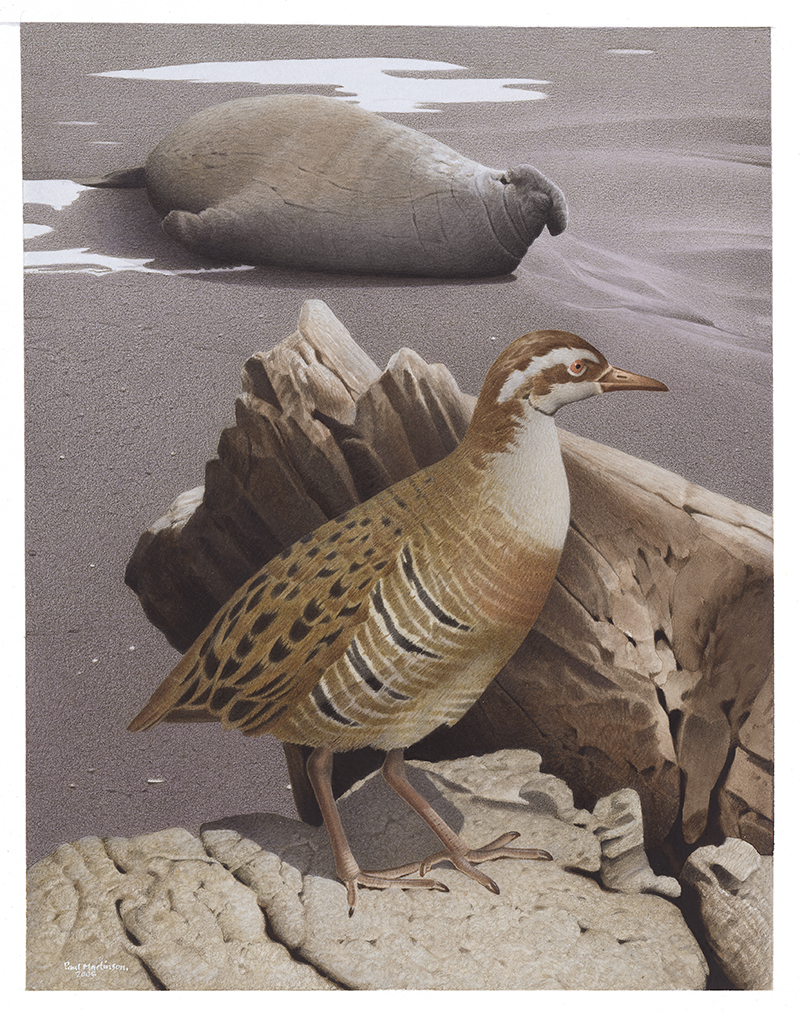Gallirallus philippensis macquariensis (Hutton, 1879:455)
Macquarie Island rail, Macquarie Island buff-banded rail
Taxonomy & Nomenclature
A complete synonymy taken from (Checklist Committee (OSNZ), 2010:180):
Rallus macquariensis Hutton, 1879: Ibis 3 (4th ser.): 455 – Macquarie Island.; Hypotaenidia macquariensis (Hutton); Hutton 1904, Index Faunae N.Z.: 30.; Eulabeornis philippensis macquariensis (Hutton); Mathews 1911, Birds Australia 1: 196.; Hypotaenidia philippensis macquariensis (Hutton); Mathews & Iredale 1913, Ibis 1 (10th ser.): 211.; Rallus philippensis macquariensis Hutton; Checklist Committee 1990, Checklist Birds N.Z.: 119.; Gallirallus philippensis macquariensis (Hutton); Marchant & Higgins 1993, HANZAB 2: 495.; Gallirallus macquariensis (Hutton); Holdaway et al. 2001, New Zealand Journ. Zool. 28(2):
132, 178.
Conservation Status
Extinct
Last record: March 1879 (Day, 1981:89); 1880 (Scott, 1882)
Distribution
Macquarie Island, New Zealand (Tasmania, Australia, politically)
Biology & Ecology
Hypodigm
Three preserved museum specimens exist (Vestjens, 1962:249), as well subfossil material collected in the 1950's and 1960's including three subfossil skulls (1 complete, 2 nearly complete) and a single subfossil cranium collected by (Ibid.).
[b]Holotype:[/b] [url=http://collections.tepapa.govt.nz/objectdetails.aspx?oid=545566]NMNZ OR.015139[/url]
Media

Above: Macquarie Island Rail. Gallirallus macquariensis. From the series: Extinct Birds of New Zealand., 2005, Masterton, by Paul Martinson. Purchased 2006. © Te Papa. CC BY-NC-ND 4.0. Te Papa (2006-0010-1/46)
References
Original scientific description:
Hutton, F. W. (1879). On a new species of rail from Macquarie Island. Ibis 21: 454-456.
Other references:
Brothers, N. P. and Skira, I. J. (1983). The Weka on Macquarie Island. Notornis 31: 145-154.
Bryant, Sally L. and Jackson, J. (1999). Tasmania's Threatened Fauna Handbook: What, Where and How to Protect Tasmania's Threatened Animals. Threatened Species Unit, DPIWE, Hobart. [p. 220-223]
Checklist Committee (OSNZ). (2010). Checklist of the Birds of New Zealand, Norfolk and Macquarie Islands, and the Ross Dependency, Antarctica (4th ed.). Ornithological Society of New Zealand & Te Papa Press, Wellington. [p. 180]
Day, David. (1981). The Doomsday Book of Animals: A Natural History of Vanished Species. New York, N.Y.: The Viking Press.
Garnett, S. T. and Crowley, G. M. (2000). The Action Plan for Australian Birds 2000. Canberra, ACT: Environment Australia & Birds Australia.
Hamilton, A. (1894). Notes on a Visit to Macquarie Island. Transactions and Proceedings of the New Zealand Institute 27: 559-579. [HTML version]
Holdaway, Richard N., Worthy, Trevor H. and Tennyson, Alan J. D. (2001). A working list of breeding bird species of the New Zealand region at first human contact. New Zealand Journal of Zoology 28: 119-187.
Hume, Julian Pender and Walters, Michael. (2012). Extinct Birds. London: T & AD Poyser.
Jones, E. (1977). Ecology of the Feral Cat Felis catus (L.), (Carnivora: Felidae) on Macquarie Island. Australian Wildlife Research 4: 249-262.
Knox, Alan G. and Walters, Michael P. (1994). Extinct and endangered birds in the collections of The Natural History Museum. British Ornithologists' Club Occasional Publications 1: 1-292.
Livezey, B.C. 1998. A phylogenetic analysis of the Gruiformes (Aves) based on morphological characters, with an emphasis on the rails (Rallidae). Philosophical Transactions: Biological Sciences (B) 353: 2077–2151.
Marchant, S. and Higgins, P. J. (co-ordinators). (1993). Handbook of Australian, New Zealand & Antarctic birds, vol. 1 - Raptors to Lapwings. Melbourne: Oxford University Press.
Matthews, Thomas J. et al. (2022). Threatened and extinct island endemic birds of the world: Distribution, threats and functional diversity. Journal of Biogeography. https://doi.org/10.1111/jbi.14474
Oliver, W. R. B. (1955). New Zealand Birds, 2nd edition. Wellington: A. H. & A. W. Reed.
Scott, John H. (1882). Macquarie Island. Transactions and Proceedings of the New Zealand Institute 15: 484-493. [HTML version]
Tennyson, Alan J. D. and Bartle, J. A. (2008). Catalogue of type specimens of birds in the Museum of New Zealand Te Papa Tongarewa. Tuhinga 19: 185-207.
Tennyson AJD and Martinson P (2006) Extinct Birds of New Zealand. Te Papa Press, Wellington.
Tennyson, Alan J. D. and Scofield, Paul R. (2012). Holocene fossil bird remains from subantarctic Macquarie Island, pp. 26. In: Worthy, Trevor H. and Göhlich, Ursula B. (eds.). 8th International Meeting of the Society of Avian Paleontology and Evolution, Abstracts.
Tennyson, Alan J. D. and Scofield, Paul R. (2013). Holocene fossil bird remains from subantarctic Macquarie Island, pp. 239-251. In: Göhlich, Ursula B. and Kroh, Andreas (eds.). Paleornithological Research 2013. Proceed. 8th Internat. Meeting Society of Avian Paleontology and Evolution.
Tyrberg, Tommy. (2009). Holocene avian extinctions, pp. 63-106. In: Turvey, Samuel T. (ed.). Holocene Extinctions. Oxford, UK & New York, USA: Oxford University Press. xii + 352 pp.
Vestjens, W. J. M. (1962). Remains of the Extinct Banded Rail at Macquarie Island. Emu 62: 249-250.
Woinarski, John C. Z., Legge, Sarah M. and Garnett, Stephen T. (2024). Extinct Australian birds: numbers, characteristics, lessons and prospects. Emu 124(1): 8-20. https://doi.org/10.1080/01584197.2023.2240345
Worthy TH and Holdaway RN (2002) The Lost World of the Moa. Indiana University Press, Bloomington.
http://www.environment.gov.au/cgi-bin/sprat/public/publicspecies.pl?taxon_id=59314
